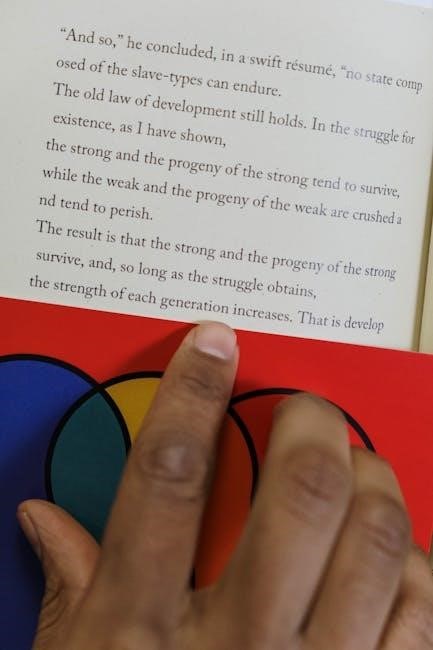
grade 1 reading comprehension pdf
Grade 1 reading comprehension introduces young learners to understanding texts, identifying main ideas, and recognizing vocabulary in context. PDF workbooks and worksheets provide engaging, skill-building activities.
Overview of Reading Comprehension Skills for Grade 1
Grade 1 reading comprehension focuses on foundational skills like identifying the main idea, understanding story sequencing, and recognizing vocabulary in context. Students learn to engage with fiction and nonfiction texts, answering questions to demonstrate understanding. Activities include matching and multiple-choice questions, as well as cloze tests to assess reading abilities. These skills are supported by resources such as Evan-Moor’s Daily Reading Comprehension and 180 Days of Reading, which provide structured practice. Additionally, free PDF worksheets and interactive activities help reinforce these concepts, ensuring students build a strong basis for future reading success. These exercises are designed to be engaging and accessible for young learners.
Importance of Developing Reading Comprehension at an Early Age
Developing reading comprehension in Grade 1 is crucial for building a strong academic foundation. Early mastery of comprehension skills enhances overall literacy, fostering a lifelong love for reading. It improves critical thinking and vocabulary, essential for future learning. By engaging with texts, students develop the ability to analyze information, identify main ideas, and understand sequences. This skill set is vital for academic success and real-world applications. Parents and educators can support this growth through guided reading sessions and interactive activities, ensuring students are well-prepared for advanced learning. Early development of these skills also boosts confidence and encourages independent learning, laying the groundwork for future achievements.

Popular Resources for Grade 1 Reading Comprehension
Popular resources include Evan-Moor’s Daily Reading Comprehension, 180 Days of Reading, and free PDFs like Reading Comprehension KG & Grade 1, offering engaging comprehension exercises and questions.
Evan-Moor’s Daily Reading Comprehension, Grade 1
Evan-Moor’s Daily Reading Comprehension, Grade 1, is a structured workbook designed to enhance reading skills through daily practice. It features 150 original fiction and nonfiction passages, each accompanied by comprehension questions. The workbook focuses on key skills such as identifying the main idea, understanding sequencing, and recognizing vocabulary in context. Suitable for both teachers and parents, it provides a comprehensive approach to building a strong foundation in reading comprehension. The activities are engaging and tailored to meet the needs of first-grade learners, ensuring they develop essential reading abilities. This resource is ideal for classroom use or home practice, offering a variety of texts to keep students engaged and motivated.
180 Days of Reading for First Grade
180 Days of Reading for First Grade offers a comprehensive daily practice program to improve reading comprehension and word-study skills. Each day includes a full page of activities, ensuring consistent learning. The workbook features engaging passages and exercises that cover essential skills like main ideas, sequencing, and vocabulary. Designed for teachers and parents, it provides a structured approach to fostering reading proficiency. With its variety of texts and activities, this resource keeps students motivated while building a strong foundation in reading. It is an effective tool for both classroom instruction and home practice, supporting the development of critical reading abilities in first graders.
Reading Comprehension KG & Grade 1 Free PDF
The Reading Comprehension KG & Grade 1 Free PDF is a valuable resource for early learners, offering engaging passages, stories, and poems paired with comprehension questions. Designed for kindergarten and first-grade students, this PDF includes a variety of texts to cater to different reading levels and interests. It features both fiction and nonfiction content, helping young readers develop essential comprehension skills. The free downloadable format makes it accessible for parents and educators to use in classrooms or at home. This resource is ideal for building foundational reading skills and fostering a love for reading in young children. Its versatility ensures it meets diverse learning needs effectively.

Key Components of Grade 1 Reading Comprehension
Grade 1 reading comprehension focuses on identifying the main idea, understanding story sequences, and recognizing vocabulary in context, enhancing foundational reading skills for young learners.
Identifying the Main Idea of a Text
Identifying the main idea is a fundamental skill in Grade 1 reading comprehension. It involves recognizing the central theme or message of a text. PDF worksheets often include short passages followed by questions that guide students to pinpoint the main idea. For example, stories like “The Ant and the Dove” or “The Black Cat” are used to help students understand the core message. Activities in resources like Evan-Moor’s Daily Reading Comprehension and 180 Days of Reading reinforce this skill through structured exercises. By mastering the main idea, students build a strong foundation for higher-level comprehension.
Understanding Sequencing in Stories
Understanding sequencing in stories is a key component of Grade 1 reading comprehension. It involves identifying the order of events within a narrative. PDF worksheets often include short stories or passages with comprehension questions that ask students to arrange events in sequence. For example, in “The Ant and the Dove,” students might be asked to list what happened first, next, and last. Activities in resources like Evan-Moor’s Daily Reading Comprehension and 180 Days of Reading provide structured exercises to practice this skill. Sequencing helps students build logical thinking and follow storylines more effectively, enhancing their overall comprehension abilities.
Recognizing Vocabulary in Context
Recognizing vocabulary in context is essential for Grade 1 students to improve reading comprehension. PDF resources, such as Evan-Moor’s Daily Reading Comprehension, include exercises where students encounter new words within stories or passages. These activities help children deduce word meanings through context clues. For instance, in “The Ant and the Dove,” students might interpret the word “swoop” by reading the surrounding sentences. Worksheets from 180 Days of Reading and free PDFs like Reading Comprehension KG & Grade 1 further reinforce this skill. By learning to identify and understand vocabulary in context, students build a stronger foundation for reading and comprehension.

Worksheets and PDF Activities for Grade 1
Grade 1 reading comprehension worksheets and PDFs are widely available for download, offering engaging stories and questions. Resources like “The Ant and the Dove” and “Fiction Stories with Comprehension Questions” help students practice understanding texts and developing reading skills through interactive exercises.
Fiction Stories with Comprehension Questions
Fiction stories with comprehension questions are a popular tool for teaching reading skills to grade 1 students. These engaging narratives, often accompanied by vibrant illustrations, capture young learners’ attention while fostering understanding. Stories like “The Ant and the Dove” and “Blanket” are frequently included in PDF resources, offering relatable themes and moral lessons. Each story is followed by a set of questions that encourage students to recall details, identify the main idea, and think critically about the plot and characters. This approach not only enhances reading comprehension but also nurtures a love for storytelling and imagination. Parents and teachers can easily download these PDFs for home or classroom use, making learning fun and accessible.
Nonfiction Articles for Grade 1 Readers
Nonfiction articles for grade 1 readers are designed to introduce young learners to factual information while developing their reading comprehension skills. Topics such as animals, nature, and simple science are often featured, making learning both educational and engaging. These texts are typically short and include visuals to aid understanding. Comprehension questions accompany each article, prompting students to identify key details and make connections to the content. PDF resources like “Nonfiction: Animals” and stories about owls provide accessible material for classroom or home use. This approach helps students build a foundation in reading nonfiction and prepares them for more complex texts in later grades.
Printable Worksheets for Home Practice
Printable worksheets for home practice are essential tools for reinforcing grade 1 reading comprehension skills. These PDF resources, such as “Grade 1 Reading Comprehension Worksheet” and “The Ant and the Dove,” offer engaging stories and questions. They are designed to help students practice identifying main ideas, sequencing events, and understanding vocabulary. Parents can easily download and print these materials, making learning convenient and accessible. Many worksheets include both fiction and nonfiction passages, ensuring a well-rounded approach to skill development. Regular use of these resources fosters consistent practice, helping students build confidence and fluency in their reading abilities while making learning fun and interactive at home.

Assessment and Evaluation Tools
Grade 1 reading comprehension PDFs include multiple-choice questions, matching exercises, and cloze tests to assess understanding and track progress in a structured, engaging manner.
Multiple Choice Questions for Reading Comprehension
Multiple choice questions are a popular assessment tool in Grade 1 reading comprehension PDFs. They provide clear options for students to demonstrate their understanding of texts. These questions often focus on identifying main ideas, sequencing events, and recognizing vocabulary in context. Designed to be engaging and straightforward, they help teachers track progress and identify areas for improvement. Many PDF resources include these questions alongside stories or passages, making them an effective way to evaluate comprehension skills in young learners. They are also useful for building confidence and developing critical thinking abilities at an early stage of reading development.
Matching Questions to Test Understanding
Matching questions are a dynamic way to assess Grade 1 reading comprehension skills, often found in PDF resources. These activities pair words, phrases, or sentences with corresponding visuals or texts, enhancing engagement. They help students connect vocabulary with context, understand sequencing, and identify main ideas. Interactive and visually appealing, matching exercises make learning fun and accessible for young readers. Many PDF workbooks include these tools, providing teachers with effective methods to evaluate comprehension while keeping students motivated. This approach supports early literacy development and fosters a strong foundation for future reading success.

Cloze Tests for Reading Skills
Cloze tests are effective tools for evaluating Grade 1 reading comprehension, often featured in PDF resources. These exercises involve passages with missing words, which students fill in using context clues. This method enhances vocabulary recognition and comprehension abilities. Cloze tests encourage critical thinking and reinforce understanding of sentence structure and story flow. Many PDF workbooks include these activities, offering teachers a versatile assessment method. By integrating cloze exercises, educators can monitor progress and help students build confidence in their reading skills. This approach is both engaging and educational, making it a valuable component of early literacy development.

Teaching Strategies for Grade 1 Reading
Effective strategies include integrating phonics with comprehension, using sight words, and incorporating real-life examples. These methods enhance understanding and engagement, fostering early literacy skills.
Phonics Integration with Comprehension
Integrating phonics with comprehension is a powerful strategy for Grade 1 reading development. By teaching students to decode words and recognize patterns, they gain the tools to read independently. Phonics skills, such as sounding out words and identifying word families, improve accuracy and fluency. This foundation enables students to focus on understanding the meaning of texts. Worksheets and activities in PDF resources often combine phonics drills with comprehension questions, ensuring a balanced approach. For example, exercises may involve reading a short story and answering questions about the main idea or sequencing events. This method reinforces both decoding and critical thinking skills, fostering a deeper connection to the material.
Using Sight Words in Comprehension Exercises
Grade 1 reading comprehension exercises often incorporate sight words to enhance fluency and understanding. Sight words are high-frequency words that students recognize instantly. Including these words in reading passages and comprehension questions helps build confidence and accuracy. PDF resources, such as Evan-Moor’s Daily Reading Comprehension, frequently embed sight words within engaging stories and activities. This approach allows students to focus on the meaning of the text without getting stuck on decoding unfamiliar words. By mastering sight words, students improve their ability to read smoothly and comprehend complex sentences, making these exercises a valuable tool for early literacy development.
Incorporating Real-Life Examples for Better Understanding
Incorporating real-life examples into Grade 1 reading comprehension exercises helps students connect texts to their personal experiences, enhancing understanding. Stories about familiar topics, such as family activities or animals, make learning relatable. PDF resources like Reading Comprehension KG & Grade 1 Free PDF often include narratives that reflect everyday life, allowing students to draw parallels and engage deeply. This approach not only improves comprehension but also sparks curiosity and a love for reading. By linking texts to real-world scenarios, teachers and parents can create meaningful learning opportunities that resonate with young learners and foster a deeper connection to the material.

Role of Parents in Developing Reading Skills
Parents play a crucial role by creating a nurturing reading environment, encouraging daily practice, and engaging in guided sessions. Their involvement boosts comprehension and fosters a love for reading.
Guided Reading Sessions at Home
Guided reading sessions at home are essential for fostering early literacy skills. Parents can create a structured environment by dedicating time each day to read with their child. Using Grade 1 reading comprehension PDFs, parents can guide their child through stories, discussing main ideas, vocabulary, and sequencing. This interactive process helps children develop critical thinking and comprehension abilities. Encouraging children to read aloud and answer questions enhances their confidence and understanding. Parents should provide support by explaining complex words and connecting stories to real-life experiences, making learning both enjoyable and effective. Consistency and patience are key to nurturing a strong reading foundation.
Encouraging Daily Reading Habits
Establishing daily reading habits is crucial for Grade 1 students to improve their comprehension skills. Parents and educators can foster a love for reading by incorporating short, engaging sessions into daily routines. Using Grade 1 reading comprehension PDFs, children can access a variety of fiction and nonfiction texts, making reading a fun and interactive experience. Setting aside 15-20 minutes each day for reading helps build consistency and fluency. Encouraging discussions about the content reinforces understanding and keeps young learners motivated. By making reading a positive and enjoyable part of their routine, children develop a strong foundation for lifelong learning and academic success.
Using Interactive Activities for Engagement
Interactive activities play a vital role in making Grade 1 reading comprehension engaging and effective. PDF resources often include quizzes, matching exercises, and fill-in-the-blank tasks that captivate young learners. Incorporating gamified reading tasks, such as identifying characters or sequencing events, enhances participation. Parents and teachers can use interactive PDFs with clickable elements to create dynamic lessons. Additionally, apps and online tools provide immersive experiences, allowing students to interact with stories and exercises digitally. These activities not only improve comprehension but also foster a love for learning by making reading a fun and hands-on experience. Regular engagement with these tools ensures consistent skill development and academic growth.

Technology and Reading Comprehension
Technology enhances Grade 1 reading comprehension through interactive tools and resources. PDFs with clickable elements, online platforms, and educational apps provide engaging ways to practice reading skills. These digital tools often include quizzes, audio narration, and progress tracking, making learning fun and accessible. Interactive PDFs allow students to engage with stories and exercises dynamically, while apps offer personalized learning experiences. Online platforms also provide access to a wide range of reading materials tailored to Grade 1 learners. By integrating technology, students can develop their comprehension skills in an immersive and enjoyable manner, preparing them for future academic success.
Online Tools for Reading Practice
Online tools provide interactive platforms for Grade 1 students to practice reading comprehension. Websites like k5learning.com offer free PDF worksheets and digital activities. Platforms such as Evan-Moor and 180 Days of Reading deliver daily practice exercises with comprehension questions. These tools often include interactive stories, audio narration, and progress tracking. They cater to different learning styles, offering a mix of fiction and nonfiction texts. Many resources are downloadable as PDFs, making them accessible for home or classroom use. These tools help students build reading fluency and understanding while engaging them with visually appealing designs and real-time feedback, fostering a love for reading and learning.
Apps for Improving Reading Skills
Apps like ReadTheory, Epic!, and Khan Academy Kids are popular for improving reading skills in Grade 1. These platforms offer interactive reading exercises, comprehension quizzes, and voice narration to support young learners. Many apps provide access to free PDF books and worksheets, making learning fun and accessible. They often include progress-tracking features, allowing parents and teachers to monitor development. Interactive games and rewards motivate students to engage with texts regularly. These tools are designed to build fluency, vocabulary, and understanding, helping students master reading comprehension in a engaging and effective way. They are ideal for both classroom and home use.
Interactive PDFs for Engaging Lessons
Interactive PDFs are a valuable resource for Grade 1 reading comprehension, offering engaging and dynamic learning experiences. These documents often include clickable buttons, drag-and-drop activities, and embedded audio for read-aloud support. Many PDFs feature fillable fields for answers, making it easy for students to complete exercises digitally. They also incorporate colorful illustrations and fun layouts to capture young learners’ attention. Resources like Evan-Moor’s Daily Reading Comprehension and 180 Days of Reading provide interactive PDFs with comprehension questions, vocabulary exercises, and sequencing activities. These tools are ideal for classroom or home use, promoting active participation and making learning enjoyable for Grade 1 students.

Future of Reading Comprehension in Grade 1
The future involves AI-driven tools, personalized learning plans, and adaptive assessments to enhance reading skills. Interactive PDFs and digital resources will play a key role in engaging young learners effectively.
Integration of AI in Reading Tools
AI is revolutionizing reading tools by creating adaptive assessments and personalized learning plans. It generates cloze tests and comprehension questions tailored to individual needs. AI-powered apps offer real-time feedback, improving accuracy and engagement. Interactive PDFs now include features like read-aloud options and vocabulary support, making learning more accessible. These tools help teachers track progress and identify areas for improvement. AI also enables multi-language support, breaking language barriers for diverse learners. By integrating AI, reading tools become more dynamic, ensuring each student receives the support they need to excel. This technology is shaping a future where learning is both effective and enjoyable for young readers.
Personalized Learning Plans for Students
Personalized learning plans tailor reading comprehension strategies to individual needs. By assessing strengths and weaknesses, teachers create targeted goals. Interactive PDFs and apps adapt content, offering tailored exercises. Real-time progress tracking helps adjust plans dynamically. These plans ensure each student receives relevant material, fostering growth. Parents and educators collaborate to monitor development, ensuring a cohesive approach. Personalized learning enhances engagement and accelerates skill mastery, making it a cornerstone of modern education. This approach ensures no child is left behind, providing a pathway to literacy success.
Adaptive Assessments for Skill Development
Adaptive assessments dynamically adjust to a student’s performance, providing appropriate challenges. These tools use AI to evaluate reading comprehension skills, tailoring questions based on responses. Multiple-choice, matching, and cloze tests are common formats. PDF resources integrate these assessments, offering immediate feedback. By identifying knowledge gaps, educators refine instruction. Parents benefit from detailed reports, enabling home support. Adaptive assessments ensure each student progresses at their own pace, fostering confidence and continuous improvement. They play a pivotal role in developing essential reading skills, making learning effective and enjoyable for Grade 1 students.
Grade 1 reading comprehension is critical for building foundational literacy skills. PDF resources and adaptive tools help students and educators track progress, fostering lifelong learning habits and academic success.
Summarizing the Importance of Grade 1 Reading Comprehension
Grade 1 reading comprehension is essential for building foundational literacy skills, enabling students to interpret texts, identify main ideas, and understand sequencing. It fosters critical thinking and vocabulary development, crucial for academic success. PDF resources like Evan-Moor’s Daily Reading Comprehension and 180 Days of Reading provide structured activities, making learning engaging. These tools help students connect stories to real-life experiences, promoting a deeper understanding of language and storytelling. Strong comprehension skills at this stage lay the groundwork for lifelong learning and intellectual growth, ensuring students are well-prepared for future challenges in education and beyond.
Encouraging Lifelong Reading Habits
Developing a love for reading in Grade 1 is vital for fostering lifelong literacy. PDF resources like Reading Comprehension KG & Grade 1 and 1st-grade reading comprehension worksheets offer engaging stories and exercises. These materials make reading enjoyable, helping students connect with texts emotionally and intellectually. By incorporating daily reading routines and interactive activities, parents and educators can nurture a child’s curiosity and enthusiasm. Lifelong reading habits not only enhance academic performance but also broaden perspectives, fostering empathy and understanding. Early exposure to diverse texts through PDFs ensures students grow into confident, curious readers ready to explore the world through words.
Final Thoughts on Effective Teaching Strategies
Effective teaching strategies for Grade 1 reading comprehension involve a blend of phonics integration, sight word recognition, and interactive activities. PDF resources like Evan-Moor’s Daily Reading Comprehension and 180 Days of Reading provide structured, engaging exercises. Incorporating real-life examples and technology, such as online tools and apps, enhances learning. Teachers should encourage active participation, offer feedback, and make reading relatable. By combining these methods, educators create a supportive environment that fosters comprehension skills and a love for reading. Consistency and creativity in teaching ensure that students build a strong foundation for future academic success and lifelong learning.